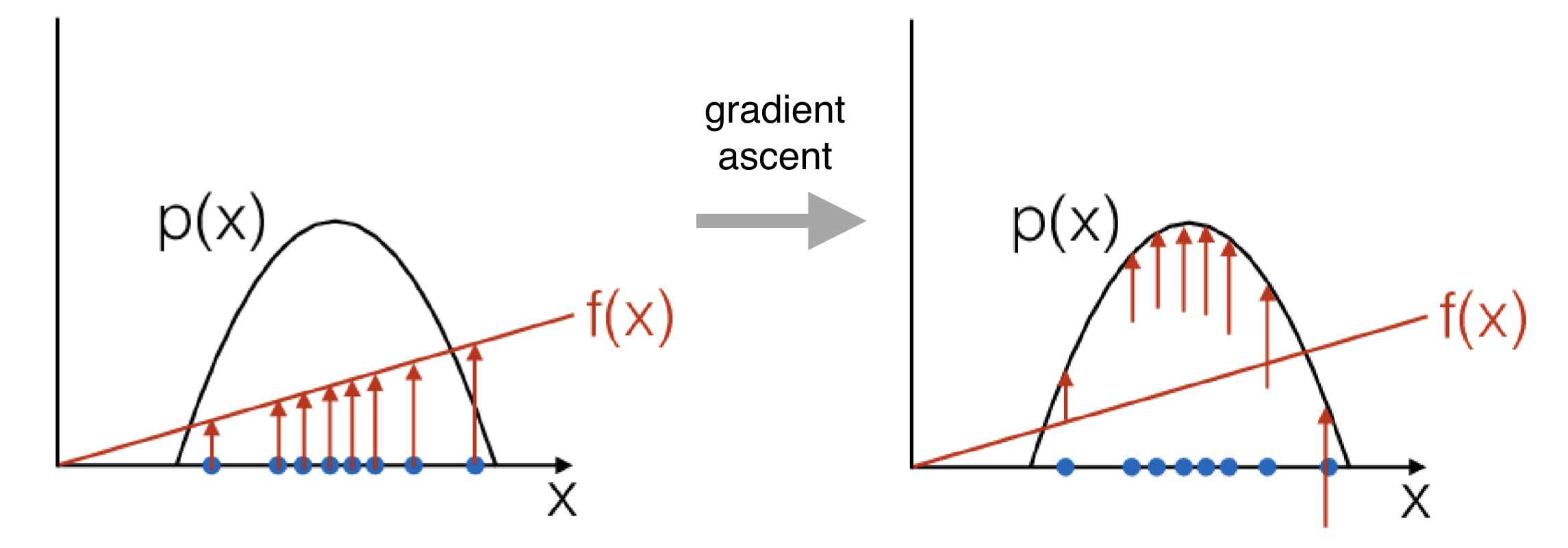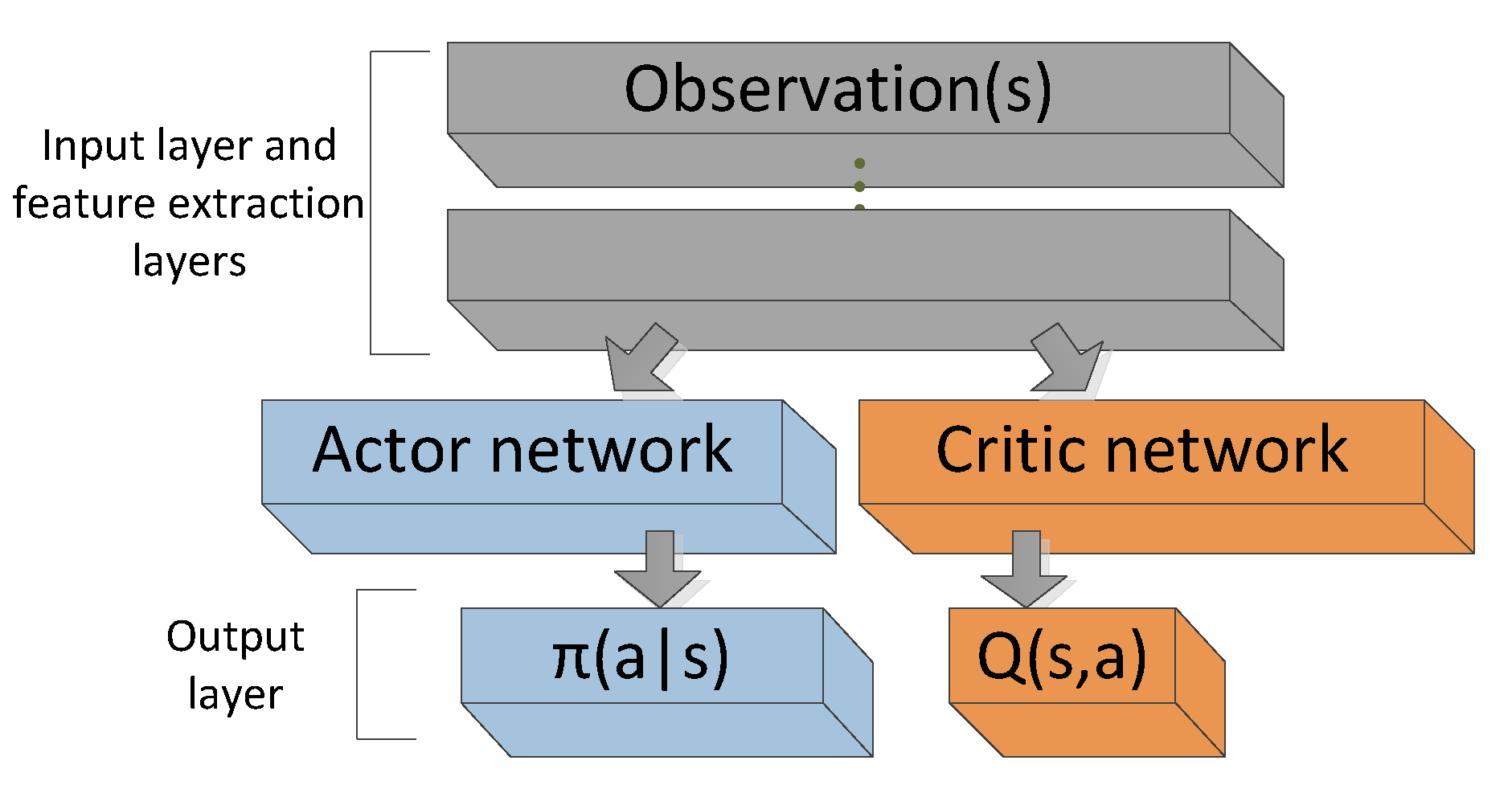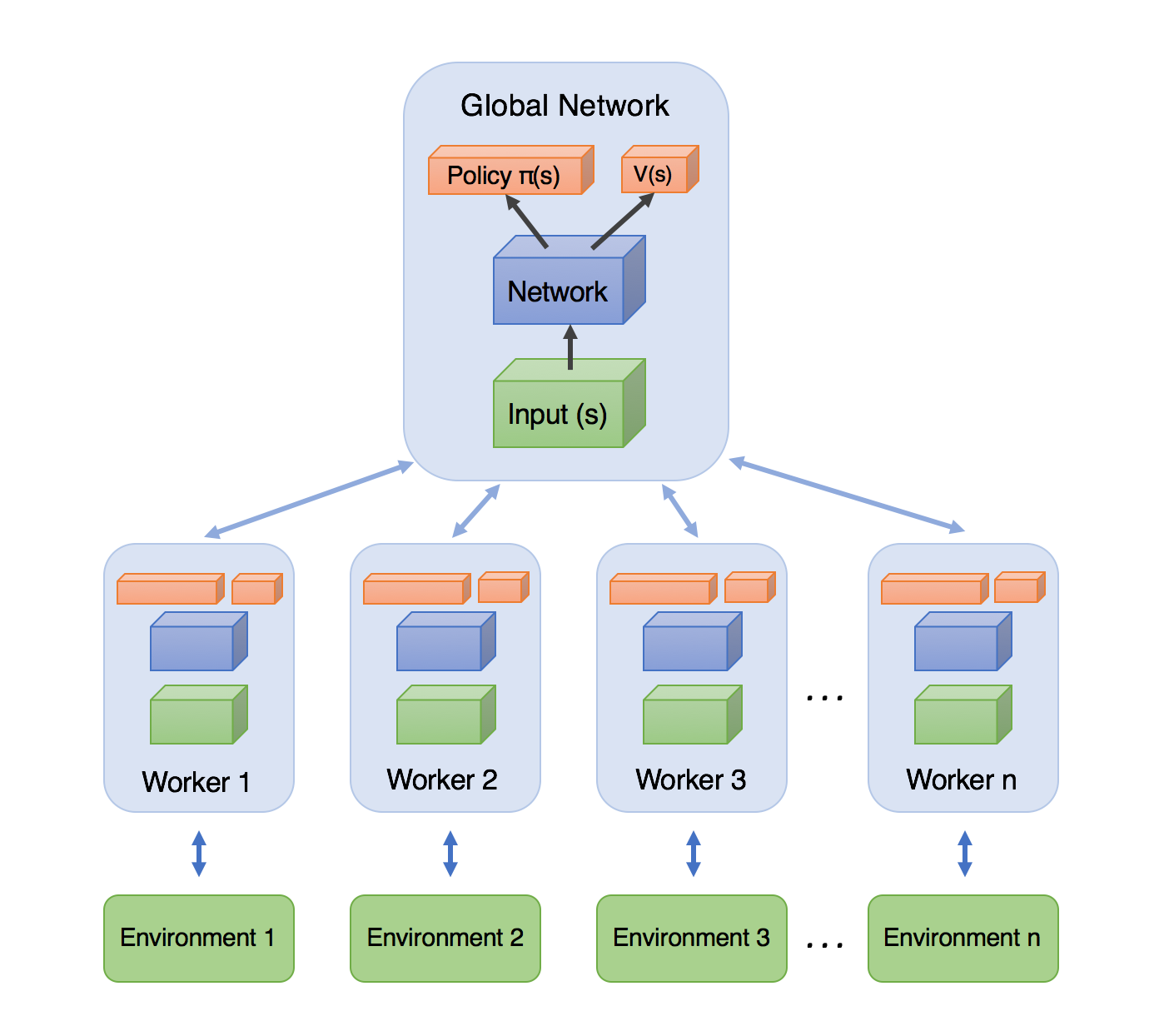Lecture 6:
Policy Gradients
Artyom Sorokin | 18 Mar
Reinforcement Learning Objective
Lets recall Reinforcement learning objective:
where:
- \(\theta\) - parameters of our policy
- \(p_{\theta}(\tau)\) - probability distribution over trajectories generated by policy \(\theta\)
- \([\sum_t] \gamma^{t} r_t\) - total episodic reward
Policy Gradients
Lets recall Reinforcement learning objective:

Reinforcement learing Objective
RL objective:
GOAL:
We want to find gradient of RL objective \(J(\theta)\) with respect to policy parameters \(\theta\)!
Policy Gradients
To maximize mean expected return:
Find:
Log-derivative trick:
Policy Gradients
Maximize mean expected return:
Gradients w.r.t \(\theta\):
We can rewrite \(p_{\theta}(\tau)\) as:
Then:
Policy Gradients
Maximize mean expected return:
Gradients w.r.t \(\theta\):
Policy Gradients:
Estimating Policy Gradients
We don't know the true expectation there:
And of course we can approximate it with sampling:
REINFORCE
Estimate policy gradients:
Update policy parameters:
REINFORCE (Pseudocode):
- Sample \(\{\tau^i\}\) with \(\pi_{\theta}\) (run the policy in the env)
- Estimate policy gradient \(\nabla_{\theta}J(\theta)\) on \(\{\tau^i\}\)
- Update policy parameters: \(\theta\) using estimated gradient
- Go to 1
PG is on-policy algorithm
To train REINFORCE we estimate this:
We can only use samples generated with \(\pi_{\theta}\)!
On-policy learning:
- After one gradient step samples are useless
- PG can be extremely sample inefficient!
REINFORCE (Pseudocode):
- Sample \(\{\tau^i\}\) with \(\pi_{\theta}\) (run the policy in the env)
- Estimate policy gradient \(\nabla_{\theta}J(\theta)\) on \(\{\tau^i\}\)
- Update policy parameters: \(\theta\) using estimated gradient
- Go to 1
Policy Gradients
Lets recall Reinforcement learning objective:
where:
- \(\theta\) - parameters of our policy
- \(p_{\theta}(\tau)\) - probability distribution over trajectories generated by policy \(\theta\)
- \([\sum^{T}_{t=0}] \gamma^{t} r_t\) - total episodic reward
We can rewrite probability of generating trajectory \(\tau\):

Policy Gradients
Lets recall Reinforcement learning objective:
where:
- \(\theta\) - parameters of our policy
- \(p_{\theta}(\tau)\) - probability distribution over trajectories generated by policy \(\theta\)
- \([\sum^{T}_{t=0}] \gamma^{t} r_t\) - total episodic reward
We can rewrite probability of generating trajectory \(\tau\):
Understanding Policy Gradient
What if we use behaviour cloning to learn a policy?

Cross Entropy-loss for each transition in dataset:
0.2
0.7
0.1
1
0
0
Ground Truth at state \(s_t\):
Policy at \(s_t\):
\(a_t\)
Understanding Policy Gradient
Gradients with behaviour clonning:
Policy Gradients:
Goal is to minimize \(J_{BC}(\theta)\)
Goal is to maximize \(J(\theta)\)
Goal is to maximize \(-J_{BC}(\theta)\)
BC trains policy to choose the same actions as the experts
PG trains policy to choose actions that leads to higher episodic returns!
Understanding Policy Gradient
Policy Gradients:
PG trains policy to choose actions that leads to higher episodic returns!

Problem with policy gradients
Probliem: hight variance!

Recal Tabular RL: Monte-Carlo Return has high variance!
Reducing Variance: Causality
Doesn't it look strange?
Causality principle: action at step \(t\) cannot affect reward at \(t'\) when \(t' < t\)
Reducing Variance: Causality
Doesn't it look strange?
Causality principle: action at step \(t\) cannot affect reward at \(t'\) when \(t' < t\)
Later actions became less relevant!
Final Version:
Improving PG: Baseline
Updates policy proportionally to \(\tau (r) \):
Updates policy proportionally to how much \(\tau (r) \) is better than average:
where:
Substracting baseline is unbiased in expectation!
(and often works better)

Entropy Regularization
Value-based algorithms (DQN, Q-learning, SARSA, etc.) use \(\epsilon\)-greedy policy to encourage exploration!
Entropy Regularization for strategy:
In policy-based algorithms(PG, A3C, PPO, etc.) we can utilize a more agile trick:

Adding \(-H(\pi_{\theta})\) to a loss function:
- encourage agent to act more randomly
- It is still possible to learn any possible probability distribution on actions
Actor-Critic Alogrithms
Final Version with "causality improvement" and baseline:
Now recall Value functions:
What is this?
Single point estimate of \(Q_{\pi_{\theta}}(s_{i,t},a_{i,t})\)
Actor-Critic Alogrithms
Combining PG and Value Functions!
What about baseline?
Has lower variance than single point estimate!
Better account for causality here....
Advantage Actor-Critic: A2C
Combining PG and Value Functions!
Advantage Function:
approximate with a sample
how much choosing \(a_t\) is better than average policy
It is easier to learn only one function!
...but we can do better:
Advantage Actor-Critic: A2C
Combining PG and Value Functions!
Advantage Function:
how much choosing \(a_t\) is better than average policy
It is easier to learn \(V\)-function as it depends on fewer arguments!
A2C Algorithm
-
Policy Improvement step:
- Train actor parameters with Policy Gradient:
-
Policy Evaluation шаг:
- Train Critic to estimate V-function (similar to DQN)
- Sample {\(\tau\)} from \(\pi_{\theta}(a_t|s_t)\) (run the policy in the env)

Recall
Policy Iteration:
No Target Network (recall DQN) here, just stop the gradients.
\(\phi\): critic parameters
A2C: Learning
-
Policy Improvement step:
- Train Actor head with Policy gradient
-
Policy Evaluation step:
- Train Critic head with MSE (similar to DQN)
- Sample {\(\tau\)} from \(\pi_{\theta}(a_t|s_t)\) (run the policy)

Policy Iteration reminder:
No actual target network, no grads
\(\phi\): different set of parameters
Implementation Details: Architecture

Asynchronous A2C: A3C
Answer: Parallel Computation!
We can't use Replay Memory, but we need to decorrelate our samples!

Each worker procedure:
- Get network params from server
- Generate samples
- Compute gradients
- Send gradients to parameter server
All workers run Asynchronously
Asynchronous A2C: A3C

Each worker procedure:
- Get network params from server
- Generate samples
- Compute gradients
- Send gradients to parameter server
All workers run Asynchronously
Pros:
- Runs Faster
Cons:
- You need N+1 parameter copies for N worksers
- Stale Gradients problem
All workers run Asynchronously
Syncronised Parrallel Actor Critic
Solution:
- Run all envs in parrallel
- Synchronize envs after each step
- Select all actions using only one network
- Update networks every t steps

It's usually called A2C... again
Syncronised Parrallel Actor Critic

Pros:
- You need to store only one network
- More stable: No stale gradients
Cons:
- A little slower than A3C
It's usually called A2C... again
A3C/A2C Results:


Thank you for your attention!
06 - Policy Gradients
By supergriver
06 - Policy Gradients
- 591



